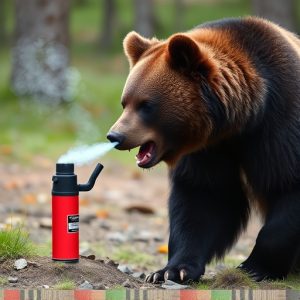Bear Spray Safety: Navigating Park Laws and Effective Use Techniques
Bear spray is a vital tool for safety in North American national parks with black bear populations,…….
Bear spray is a vital tool for safety in North American national parks with black bear populations, governed by varying Bear Spray Laws that dictate usage and storage. Understanding local regulations, including brand choices and application techniques, is crucial for effective use during potential encounters. Correct usage provides valuable time to escape or deter charges, but it's only one part of a comprehensive safety strategy that includes staying alert, noise-making while hiking, secure food storage, and adhering to park guidelines for wildlife interaction. Following these measures ensures visitors can enjoy national parks safely, minimizing conflicts with bears.
“Navigating national parks comes with an inherent risk of bear encounters, making understanding and preparing for potential dangers crucial. This comprehensive guide delves into the world of bear spray—a popular defense mechanism against aggressive black bears. We explore ‘Bear Spray Laws in National Parks,’ dissecting regulations to ensure safe outdoor adventures. Learn about different spray types, their effectiveness, and safety protocols. Additionally, discover proactive strategies to avoid bear encounters, ensuring your park visits remain memorable for all the right reasons.”
- Understanding Bear Spray: What It Is and How It Works
- Bear Spray Laws in National Parks: A Comprehensive Overview
- Choosing the Right Bear Spray for Your Needs
- Proper Use and Safety Tips for Bear Spray
- Effective Strategies for Avoiding Bear Encounters in National Parks
Understanding Bear Spray: What It Is and How It Works
Bear spray, also known as pepper spray designed for wildlife encounters, is a powerful tool for personal safety in areas where black bears are present. It’s more than just a deterrent; it’s a specialized defense mechanism that works by targeting the bear’s eyes and respiratory system. When sprayed, capsaicin, the active ingredient, irritates these sensitive areas, causing the bear to experience temporary disorientation and discomfort, allowing you time to retreat or defend yourself further.
Understanding bear spray laws in national parks is crucial for visitors. Each park has specific regulations regarding its use, including permitted areas, application methods, and storage. Knowing these rules ensures safe and responsible usage, which can be a game-changer when facing potential bear encounters. Bear spray is often recommended as an effective measure to reduce the risk of attacks, but it’s important to remember that no single method guarantees 100% protection. Always stay alert, make noise while hiking, carry food securely, and follow park guidelines for safe wildlife interaction.
Bear Spray Laws in National Parks: A Comprehensive Overview
In many national parks across North America, carrying bear spray is mandatory for visitors due to the prevalence of black bears in these areas. These parks have implemented Bear Spray Laws to ensure visitor safety and reduce conflicts with bears. The laws vary from park to park, but generally, visitors are required to carry and know how to use bear spray as a deterrent when hiking or camping in grizzly bear country. Failure to comply can result in fines or other penalties.
The Bear Spray Laws in national parks aim to create a safe environment for both visitors and bears. By educating hikers on proper usage and ensuring they have the spray, park rangers can minimize the risk of unexpected encounters. It’s crucial for park-goers to understand that bear spray is not 100% effective but can provide valuable time for escape or deter a charge if used correctly. Many parks also offer demonstrations and training sessions to help visitors feel more prepared and confident when venturing into areas with black bears.
Choosing the Right Bear Spray for Your Needs
When selecting bear spray, understanding your specific needs and local regulations is crucial. Different areas, including national parks, may have varying bear spray requirements. Always check the Bear Spray Laws National Parks before packing yours for a trip. For instance, some parks mandate specific brands or concentrations while others have size restrictions on containers.
Consider factors like intended use—defensive or offensive—and terrain. If you’re hiking in dense forests, a stronger spray with a wider reach might be ideal. Urban areas might require a lighter, shorter-range option. Additionally, check expiration dates and ingredients to ensure effectiveness and safety.
Proper Use and Safety Tips for Bear Spray
Using bear spray correctly and safely is crucial for anyone venturing into areas known for black bear populations, especially within National Park boundaries. Before heading out, ensure you understand your local Bear Spray Laws and regulations. Familiarize yourself with the type of spray you’re carrying, as different brands and strengths have varying range and effectiveness. Always keep it readily accessible, preferably in an easily reachable holster or backpack pocket.
When faced with a bear, remain calm and assess the situation. If you notice a bear but it hasn’t noticed you, slowly back away. If a bear does spot you, stop, drop to the ground, and play dead. In most cases, bears will lose interest and leave. However, if it continues its approach or makes aggressive movements, activate your spray. Aim for the bear’s face from a safe distance (typically 20-30 feet), creating a barrier of foam between you and the animal. Use the entire contents of the canister, making sure to follow the manufacturer’s instructions for optimal results in National Parks and other wildland settings.
Effective Strategies for Avoiding Bear Encounters in National Parks
Avoiding bear encounters in national parks is a priority for both visitors and park rangers alike. While bear spray is an essential defense tool, preventing encounters altogether is even more effective. Bear spray laws vary across national parks, but many mandate its use within certain distances from bears. Understanding these laws and knowing how to react when encountering a bear are crucial. Staying on designated trails, making noise to deter bears, and carrying bear spray appropriately can significantly reduce the risk of an attack.
Rangers often advise visitors to maintain a safe distance from bear habitats and avoid surprising bears by moving slowly and speaking softly. Additionally, properly storing food in bear-resistant containers is essential, as hungry bears are more likely to approach human camps or picnic areas. By adhering to park guidelines and practicing responsible wilderness behavior, visitors can enjoy their time in national parks while minimizing the chances of a potentially dangerous bear encounter.
When visiting national parks, understanding bear spray laws and proper usage is essential for your safety. By choosing the right bear spray tailored to your needs and adhering to safety tips, you can effectively protect yourself against potential black bear encounters. Remember, prevention is key, but knowing how to use bear spray can be a valuable skill in these wild environments. Always stay informed about local Bear Spray Laws in National Parks to ensure a safe and enjoyable outdoor experience.


